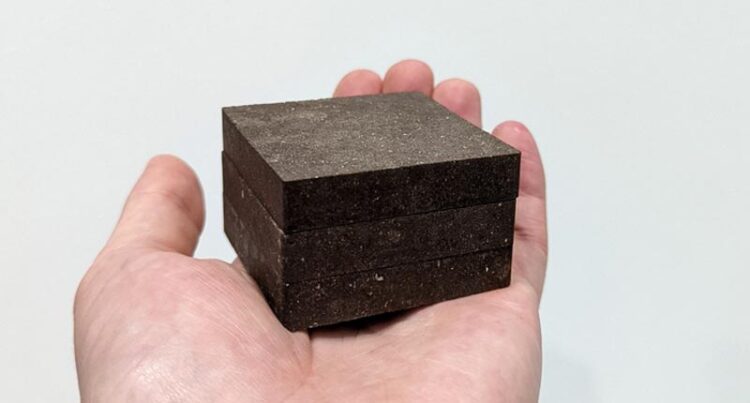Scientists develop a ‘cosmic concrete’ that is twice as strong as regular concrete

Starcrete - Aled Roberts
Credit: Aled Roberts
Manchester scientists have created a new material, dubbed ‘StarCrete’ which is made from extra-terrestrial dust, potato starch, and a pinch of salt and could be used to build homes on Mars.
Building infrastructure in space is currently prohibitively expensive and difficult to achieve. Future space construction will need to rely on simple materials that are easily available to astronauts, StarCrete offers one possible solution. The scientists behind the invention used simulated Martian soil mixed with potato starch and a pinch of salt to create the material that is twice as strong as ordinary concrete and is perfectly suited for construction work in extra-terrestrial environments.
In an article published in the journal Open Engineering[EB1] , the research team demonstrated that ordinary potato starch can act as a binder when mixed with simulated Mars dust to produce a concrete-like material. When tested, StarCrete had a compressive strength of 72 Megapascals (MPa), which is over twice as strong as the 32 MPa seen in ordinary concrete. Starcrete made from moon dust was even stronger at over 91 MPa.
This work improves on previous work from the same team where they used astronauts’ blood and urine as a binding agent. While the resulting material had a compressive strength of around 40 MPa, which is better than normal concrete, the process had the drawback of requiring blood on a regular basis. When operating in an environment as hostile as space, this option was seen as less feasible than using potato starch.
“Since we will be producing starch as food for astronauts, it made sense to look at that as a binding agent rather than human blood. Also, current building technologies still need many years of development and require considerable energy and additional heavy processing equipment which all adds cost and complexity to a mission. StarCrete doesn’t need any of this and so it simplifies the mission and makes it cheaper and more feasible.
“And anyway, astronauts probably don’t want to be living in houses made from scabs and urine!” Dr Aled Roberts, Research Fellow at the Future Biomanufacturing Research Hub, and lead researcher for this project.
The team calculate that a sack (25 Kg) of dehydrated potatoes (crisps) contain enough starch to produce almost half a tonne of StarCrete, which is equivalent to over 213 brick’s worth of material. For comparison, a 3-bedroom house takes roughly 7,500 bricks to build. Additionally, they discovered that a common salt, magnesium chloride, obtainable from the Martian surface or from the tears of astronauts, significantly improved the strength of StarCrete.
The next stages of this project are to translate StarCrete from the lab to application. Dr Roberts and his team have recently launched a start-up company, DeakinBio, which is exploring ways to improve StarCrete so that it could also be used in a terrestrial setting.
If used on earth, StarCrete could offer a greener alternative to traditional concrete. Cement and concrete account for about 8% of global CO2 emissions as the process by which they are made requires very high firing temperatures and amounts of energy. StarCrete, on the other hand, can be made in an ordinary oven or microwave at normal ‘home baking’ temperatures, therefore offering reduced energy costs for production.
Journal: Open Engineering
DOI: 10.1515/eng-2022-0390
Article Title: StarCrete: A starch-based biocomposite for off-world construction
Article Publication Date: 16-Mar-2023
Media Contact
Ben Robinson
University of Manchester
ben.robinson@manchester.ac.uk
Office: 01-612-750-134
All latest news from the category: Materials Sciences
Materials management deals with the research, development, manufacturing and processing of raw and industrial materials. Key aspects here are biological and medical issues, which play an increasingly important role in this field.
innovations-report offers in-depth articles related to the development and application of materials and the structure and properties of new materials.
Newest articles

Superradiant atoms could push the boundaries of how precisely time can be measured
Superradiant atoms can help us measure time more precisely than ever. In a new study, researchers from the University of Copenhagen present a new method for measuring the time interval,…

Ion thermoelectric conversion devices for near room temperature
The electrode sheet of the thermoelectric device consists of ionic hydrogel, which is sandwiched between the electrodes to form, and the Prussian blue on the electrode undergoes a redox reaction…

Zap Energy achieves 37-million-degree temperatures in a compact device
New publication reports record electron temperatures for a small-scale, sheared-flow-stabilized Z-pinch fusion device. In the nine decades since humans first produced fusion reactions, only a few fusion technologies have demonstrated…





















